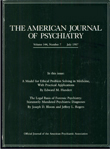Decreased motor inhibition in Tourette's disorder: evidence from transcranial magnetic stimulation
Abstract
OBJECTIVE: Fluctuating motor and vocal tics are the diagnostic feature of Tourette's disorder. The pathophysiology of tics is still unclear. One major hypothesis is a deficient inhibitory control through the cortical-striatal-thalamic-cortical motor loop. The authors tested this hypothesis by investigating motor cortex excitability through use of the technique of transcranial magnetic stimulation. METHOD: Twenty patients with Tourette's disorder and a comparison group of 21 healthy subjects were studied. Focal transcranial magnetic stimulation was applied to the left motor cortex, and surface electromyography (EMG) was recorded from the right abductor digiti minimi muscle. As measures of motor cortex excitability, motor threshold, cortical silent period, and intracortical inhibition and facilitation were studied. The peripheral silent period and the maximum M wave after supramaximal electrical stimulation of the ulnar nerve at the wrist were also determined. RESULTS: Motor threshold and peripheral motor excitability were normal in the Tourette's disorder group, but the cortical silent period was shortened and the intracortical inhibition reduced. A subgroup analysis of the patients with Tourette's disorder revealed that these abnormalities were seen mainly when tics were present in the EMG target muscle or in patients without neuroleptic treatment. Age, sex, attention deficit hyperactivity disorder, obsessive-compulsive disorder, and sensory urges had no significant effect on motor excitability. CONCLUSIONS: Findings are consistent with the hypothesis that tics in Tourette's disorder originate either from a primarily subcortical disorder affecting the motor cortex through disinhibited afferent signals or from impaired inhibition directly at the level of the motor cortex or both.



